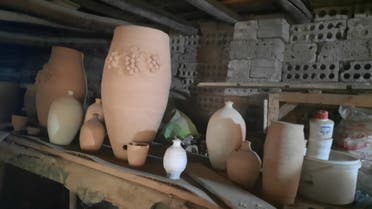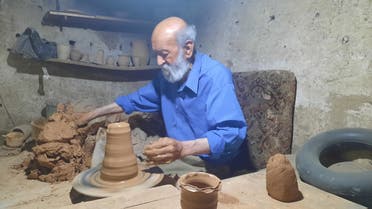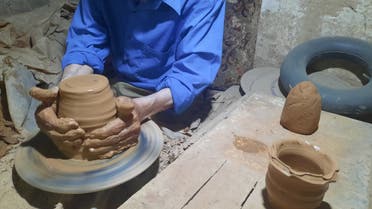The last Fawakherji in Qamishli.. A profession that accompanied his family for 400 years

Inside his old mud workshop in the courtyard of his house in the Al-Tay neighborhood on the outskirts of the city of Qamishli, northeastern Syria, Uncle Misak Bedrosian, an Armenian who is nearly ninety years old, perseveres in practicing the ancestral profession that he inherited from his family four and a half centuries ago.
Uncle Misak stomps his feet on the pottery wheel in his mud factory, with its low wooden ceiling, crumbling walls and old-fashioned mud floors.
As the elderly Armenian passes his fingers over the pieces of clay to adjust them as he likes, then artistic formations of different sizes emerge from between his palms that dazzle the hearts.
The last Fawakherji on the island
This old man inherited this heritage profession to his children and grandchildren, and he is one of the pioneers of pottery and the first and last pottery industry in the Syrian Jazira region.
He also mastered four languages, namely his mother tongue, Armenian, Kurdish, Arabic, and Turkish, but he and his family prefer to speak Kurdish, like most Armenian families in northeastern Syria.
As for his profession, he said in an interview with Al-Arabiya.net: “I used to watch my father, my grandfather and my uncles, as they made the finest types of pottery in the city of Susan, Turkey, before we immigrated.”

to Aleppo
Uncle Maysak recounted the family’s escape from the massacres of the Ottomans in Turkey towards Syria, to end up in Qamishli, saying: “My father arrived in the city of Aleppo, and from there he moved to Qamishli, and opened his small workshop in the Qudourbek neighborhood, after which the family traveled to the southern outskirts of the city, which became known as Today, Tai Haret, which did not exist nearly eighty years ago.
He also added, “We built our house since that time, and it is still the same… We started our work in the profession, and over the years, people flocked to live near us, until it turned into a large popular neighborhood, and we were the first founders of it.”

run over with legs
As for the stages of making pottery, the old man confirmed that he himself was careful to select the type of soil, and put it in special basins prepared for that for days, after sifting it and trampling it underfoot.
Then Anton Ibn Misak, who is forty-five years old, undertakes the kneading process with the legs and in the primitive way, and softens large quantities of clay with water until it is ready to be formed on the manufacturing wheel that Misak and his son take turns working on, and manufactures pottery skirts, vases, piggy banks, mate pots, and special orders that some customers desire.

After that, the son and father prepare the manufactured pottery to put it in two ovens, one of which is inside the manufacturing workshop for small pots, and the second in the courtyard of the house is for large pieces such as skirts. The drying stage begins by exposing it to the air, after which it is roasted in the clay oven at a high temperature, with a temperature of 1200 degrees, for about 15 hours, and is left to cool and ready for sale.
Low turnout
And about the demand of customers to buy his exhibits, he said: “The demand is low compared to previous years, and our work is related to the special requests of customers, but recently we have been receiving requests from restaurant owners who prefer to cook some foods in clay pots and serve them to their customers, due to the health value of pottery cooking.” “.
The Armenian uncle recalled the previous seasons of blessing – as he described them – and the pressure of working for long hours to meet the requests of the nursery owners, who used to grow various varieties of roses, basil and seedlings in clay pots. their prices.
We will pass it on to our grandchildren.
Several workshops in Aleppo, Damascus, Idlib, and Qamishli continue to make pottery throughout Syria, despite the conditions of war the country experienced, and the owners are trying to preserve the profession of fathers and grandfathers from disappearance, despite the decline in the acquisition and use of pottery, as Misak Bedrosian explained in his speech.
“We will resist, preserve and hold on to the legacy of our ancestors, and we will pass it on to our children and grandchildren,” he concluded.
xnxx,
xvideos,
porn,
porn,
xnxx,
Phim sex,
mp3 download,
sex 4K,
Straka Pga,
gay teen porn,
Hentai haven,
free Hentai,
xnxx,
xvideos,
porn,
porn,
xnxx,
Phim sex,
mp3 download,
sex 4K,
Straka Pga,
gay teen porn,
Hentai haven,
free Hentai,




